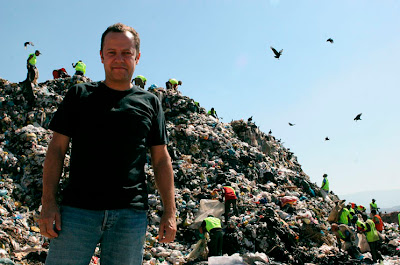Joy of such immense proportion is provided by Lucy Walker in her new documentary WASTE LAND that it almost seems as though she is trying to make up for scaring the pants off some people, while driving others of us to annoyed distraction via her recent film -- the repetitive and heavy-handed antinuclear broad-side Countdown to Zero. That this great joy comes from the unlikely combination of art, garbage and the people who pick through it to find useable/
recycable materials is only part of the film's surprise and appeal. The rest is provided by the artist in charge, Vik Muniz and the half-dozen or so workers that he chooses to use and whom Ms Walker (shown below) captures fleetingly -- yet so fully and beautifully.
When Mr. Muniz -- a highly successful born-in-Brazil, lives-in-Brooklyn artist who had determined to give something back to his ever-beleaguered third-world country -- hit upon using Rio de Janeiro's Jardim Gramacho as a subject of his mixed-media art, he could hardly have know just how produc-tive this would be. (The artist is shown below, standing on a part of this, the world's largest garbage dump.) Of the workers Muniz meets, a few begin to stand out, and each has a fascinating history, which we soon learn.
We watch these workers on the job and visit them in their homes. What appears on screen carries not a whiff of condescension, neither toward the workers nor us viewers. The attitude toward these waste pickers from the general Brazilian public is made known, and how the workers deal with this soon comes clear. The pickers are savvy, caring people, who understand that, though their choices may be limited, they still have choices. How they put these to use is part of what makes Waste Land so involving and moving.
From this large group of men and women, Muniz concentrates on only a few: the workers' chief organizer Tião (above), who ends up posing for the artist's redition of Marat in his bath (Tião's discovery of a tossed-out bathtub leads to this) -- the finished art for which is shown on the poster at top and at the bottom of this post.
The friendly, happy, elderly Irma, who's been at the dump for 26 years, becomes an icon of stately beauty in the portrait the artist creates of her, below (and in close-up, above).
Isis and Valeria, below, and Suelem (further below, at left) are among the younger women whose lives and homes we enter, and who often surprise us with their attitudes toward work, love and the world outside this garbage dump.
One picker prefer night shifts -- cooler temperatures, less people to contend with -- while another offers helpful hints on how to bag one's trash ("You can always identify trash from the poor by the way it is bagged," he explains). Then suddenly the whole movie and its cast is staggered by a terrible event that seems to pull the rug from under everything.
But our workers bounce back, and what happens to the art they've helped create leads the movie into its final stage. Vic and Tião head for London to a museum (probably the New Tate) about which Tião seems bemused: "Art has to communicate something, at least," he decides. Back in Brazil, a local museum show brings together labor, self-esteem, cooperation and art into the kind of transforming event one rarely encounters.
The flow of Walker's film is just lovely: easy, sweet and fleet. The joy you're feeling by the end of Waste Land proves fine art to be not something merely beautiful or meaningful but absolutely essential to civilized society. Walker, Muniz and their subjects connect art to humanity in an insoluble manner.
The movie opens Friday, October 29, at NYC's Angelika Film Center, and on November 5, at L.A.'s NuArt Theater. Further showings can be found by clicking here, then scrolling from bottom to top for the more recent and upcoming screenings.
Tuesday, October 26, 2010
WASTE LAND Lucy Walker's joyous journey into the social and economic uses of art
Labels:
Art,
Brazil,
Brooklyn,
Lucy Walker,
Vic Muniz
Subscribe to:
Post Comments (Atom)
















No comments:
Post a Comment